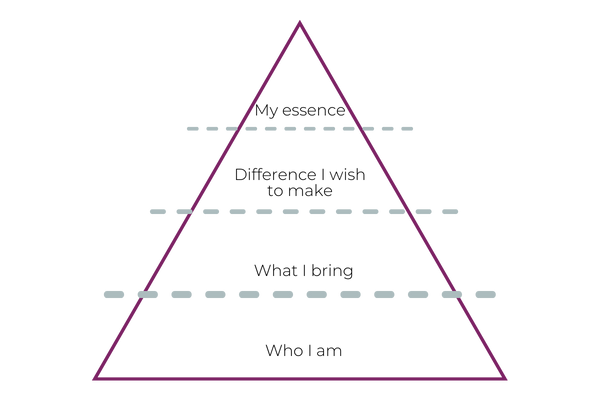In my executive coaching work, I often spend time with leaders working on their values as the principles they work to and which others need to understand. We also spend time on the strengths and skills that mark them out as unique.
For some leaders we also talk purpose – what difference they want to make and what legacy they want to leave as a leader. And for other leaders, we work on their gravitas and building a strong reputation – how they can be seen as credible, confident and trustworthy.
In this podcast, I combine all of these elements into one activity which will help shape your communication of what’s important to you and how you can make an intentional positive impact as a leader.
Today’s podcast is all about building your leadership brand.
A leadership brand helps you in several ways:
- To differentiate yourself in competitive internal and external marketplaces
- To increase your visibility in your organisation and make others aware of your value
- To ensure people have a clear sense of who you are and how to work with you
- To become more self-confident and self-motivated as you gain self-awareness and clarity about what you have to offer and how that marks you out as positively different.
Building your leadership brand pyramid
Onto the activity. There are plenty of ways of doing this but my favourite is to use a pyramid – practically, there’s more space to capture what you need to at the fat end but the shape also shows the importance of the base layers as providing you with strong foundations for your leadership proposition and legacy, which sit at the pointy end. So first thing is to draw a pyramid with four layers or levels.

“Who I am” – Values and attitudes
Values and attitudes are the bedrock of your leadership brand
The base level includes the core values and attitudes that guide your leadership. I recommend James Clear’s list of values as a good starter for inspiring your own values list. Try and keep it as a relatively short list, say 7-8 and do use your own language.
Think about the things you truly value and hold dear, the way you feel that the world should be, the behaviours or actions in others that anger you – all of these point to your key values and attitudes. This is important because everyone’s values are different – they come to us from our upbringing and from our experiences through life. We can’t assume that anyone else sees the world in the same way that we do.
So think about the people who work for you – would it help them and you if they knew what you valued? Think of this list as a ‘survival guide’ or playbook in working with you – if the people who work for you act in alignment with your values, you’re more likely to see them in a positive light. And if they do something that is out of alignment with your values, they can expect that it won’t sit well with you.
It’s very important therefore to capture these as the bedrock foundations of the other brand elements.
“What I bring” – Strengths, skills and experience
Strengths, skills and experience are the ‘features’ of your leadership brand.
Second layer are your strengths and skills and expertise – if you thought of yourself as a product, this level would contain your ‘features’. Your Strengthscope Standout 3 strengths sit here, along with the leadership skills that you want to bring to your role, whatever they may be – strategic vision, networking and relationships, project management capability, flexibility, critical analysis – whatever your gifts and talents and features are.
If you’re not 100% sure, you can always ask for feedback from others who know you well.
Where do they see you at your best?
What do they see as your greatest leadership strengths and talents?
“The difference I wish to make” – Your leadership legacy
Your leadership legacy communicates the benefits of your personal leadership brand.
If the second layer up included your product ‘features’, this layer includes the ‘benefits’ of those features. Think of this level as the difference you want to make and/or the leadership legacy you want to leave.
Try and get this down to an inspiring ‘statement of intent’ around your core purpose. A couple of examples: ‘I create environments where teams thrive and I support each individual to reach their true potential’ or ‘I build and deliver strategic plans which always create measurable value for my organisation’.
It needs to evoke emotions in you (and possibly others, but mainly you because it is intended to stimulate you towards action) and it should be something that sets you apart as being different.
“My essence”
Your essence gives you a strong leadership brand promise.
OK, top and final layer is your essence – when you are at your best and most energised and the reason others would follow you. 10 words max, ideally fewer, in fact the fewer the better. The idea here is to capture a statement that when you say it or others hear it, it will inspire the kind of people who you would want around you to get around you.
Think of this as a leadership brand statement or a brand promise if you like.
What’s next: developing your leadership brand management plan
So that’s quite a bit of work, it’ll take time to hone.
Once you have, say the words out loud to yourself (particularly those in the top two layers) and test your own reaction. Does what you have sit right with you? Does it feel like you? Can you own it? Or does it feel awkward, does the language not quite work for some reason, might you just feel embarrassed if you were asked to describe your brand in this way to your team?
Then do some more work until it feels right. It will be a mix of the now and the future, of what you have attained already and your aspiration and ambition for your leadership future.
Make sure it’s sufficiently ‘now’ that it represents a reasonably accurate picture of how people will experience you today – they need to be able to recognise you. But make sure it has a future-focused perspective too, so that you have something to move towards, space to grow into.
Once you’re happy with your leadership brand, you’re going to need a leadership brand communication plan. So I have some reflection questions for you to ask yourself which should help.
How close are your stakeholders’ perceptions of your current leadership approach to your ideal leadership ‘brand’? What do you need to do more of, less of, or differently to close the ‘gap’?
So these questions are getting you to think about your behaviour and what others see in you day to day that will lead them to conclude that your brand is aligned with the human in front of them. And we all have work to do on that.
Do you need to make your values more visible or talk to more people about them? Do you need to communicate the value that your strengths and skills and expertise can bring? And to whom? And who knows about the legacy you want to leave right now, and who would you like to know?
How will you communicate your leadership brand to colleagues, direct reports and other stakeholders?
Once you’ve worked out where your gaps are in terms of people’s perceptions right now and how you would want ‘brand you’ to be seen, you can get to work on a comms plan, a brand management plan, that will help you get the right messages to the right people in the right ways.
For example – translating your values into leadership behaviours and behaving consistently with them. Talk to your team about your values maybe at an all-hands meeting, where you ask them to share theirs too or maybe 121 with your top team.
What about your legacy and your essence – ideally you would want more senior folk to see and hear this so work on an elevator pitch that you can switch on if you get the opportunity to be in front of your plus ones, plus twos or plus threes.
What immediate steps can you take to start communicating and living your leadership brand right now?
Finally, start taking steps today. Small actions can make a big difference but you’ll need to make those actions habitual and repeat them consistently over time if you want others to shift their current perceptions or to solidify a view that they may of you already.
In conclusion: the benefit of working on your personal brand as a leader
Strong personal brands are not built overnight, they take a long time to build. It’s worth it though, as all great brands produce strong results in terms of improved demand, perceived value, reputation and results. I hope you’ve this blog useful. If you have, please subscribe on your favourite platform (button below) and share it with others who you feel might find it useful. ‘Till next time, stay strong.
You can find this podcast on Apple podcasts, Spotify, Google podcasts, Stitcher, ACast, TuneIn, Breaker and Soundcloud. Please support it by subscribing to get it at the start of the working week!












